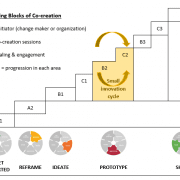Training vs. Learning: Do you want to train? Or have someone learn?
Training successfully educates only those who are predisposed to the new material. Others may endeavor to learn during class but may not permanently adopt it. The problem isn’t the value of information or the eagerness of the learner: It’s a problem with both the training model itself and the way learners learn. It’s a systems/change problem.
How We Learn
We all operate out of unique, internal systems comprised of mental models (rules, beliefs, history etc.) that form the foundation of who we are and determine our choices, behaviors and habits. Our behaviors are the vehicles that represent these internal systems – our beliefs in action, if you will. So as a Buddhist I wouldn’t learn to shoot a gun, but if someone were to try to kill my family I’d shift the hierarchy of my beliefs to put ‘family’ above ‘Buddhist’ and ‘shooting a gun’ might be within the realm of possibility.
Because anything new is a threat to our habitual and carefully (unconsciously) organized internal system (part of our limbic brain), we instinctively defend ourselves against anything ‘foreign’ that might seek to enter. For real change (like learning something new) to occur, our system must buy-in to the new or it will be automatically resisted. It similarly effects selling/buying, coaching/clients, doctors/patients, leaders/followers.
A training program potentially generates obstacles, such as when
- learners are happy with their habitual behaviors and don’t seek anything new,
- fear they might lose their historic competency,
- the new material unconsciously opposes long-held beliefs.
We are programmed to maintain our status quo and resist anything new unless our beliefs/mental models recognize that the new material will align with our status quo regardless of the efficacy of the required change.
How We Train
The training model assumes that if new material
- is recognized as important, rational, and useful,
- is offered in a logical, informative, interesting way,
- allows time for experience and practice,
it will become accepted and habituated. But these assumptions are faulty. At an unconscious level, this model attempts to push something foreign into a closed system (our status quo): it might be adopted briefly, but if it opposes our habituated norm, it will show up as a threat and be resisted. This is the same problem faced when sellers attempt to place a new solution, or doctors attempt to change the habits of ill patients. It has little to do with the new, and everything to do with change management.
Truly experiential learning has a higher probability of being adopted because it uses the experience – like walking on coals, doing trust-falls with team members – to shift the underlying beliefs where the change takes place. Until or unless there is a belief change, and the underlying system is ready, willing, and able to adopt the new material into the accepted status quo, the change will not be permanent.
One of the unfortunate assumptions of the training field is that the teach/experience/practice model is effective and if learning doesn’t take place it’s the fault of the learner (much like sellers think the buyer is the problem, coaches thinks clients are the problem, and Listeners think Speakers are the problem). Effective training must change beliefs first.
Learning Facilitation
To avoid resistance and support adoption, training must enable
- buy-in from the belief/system status;
- the system to discover its own areas of lack and create an acceptable opening for change
before the new material is offered.
I had a problem to resolve when designing my first Buying Facilitation® training program in 1983. Because my content ran counter to an industry norm (sales), I had to help learners overcome a set of standardized beliefs and accepted processes endemic to the field. Learners would have to first recognize that their habitual skills were insufficient and higher success ratios were possible by adding (not necessarily subtracting) new ones. I called my training design Learning Facilitation and have used this model successfully for decades. (See my paper in The 2003 Annual: Volume 1 Training [Jossey-Bass/Pfieffer]: “Designing Curricula for Learning Environments Using a Facilitative Teaching Approach to Empower Learners” pp 263-272).
Briefly: Day 1 helps learners recognize the components of their unconscious status quo while identifying skills necessary for greater excellence: specifically, what they do that works and what they do that doesn’t work, and how their current skills match up with their unique definition of excellence within the course parameters. Day 2 enables learners to identify skills that would supplement their current skills to choose excellence at will, and tests for, and manages, acceptance and resistance. Only then do new behaviors get introduced and practiced.
Course material is designed with ‘learning’ in mind (rather than content sharing/behavior change), and looks quite different from conventional training. For example Day 1 uses no desks, no notes, and no lectures. I teach learners how to enlist their unconscious to facilitate buy-in for new material.
Whether it’s my training model or your own, just ask yourself: Do you want to train? Or have someone learn? They are two different activities.
About the Author













Leave a Reply
Want to join the discussion?Feel free to contribute!